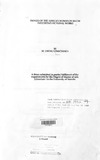| dc.description.abstract | The study is a literary analysis of the images of the African woman in Buchi Emecheta's fictional works. Four texts that more exhaustively handle the issues surrounding the image and position of the African woman were selected.
The first section of the study is devoted to the writer and her works. Within this section a survey is done to demonstrate that the works of fiction under study have been greatly influenced by the author's own personal life experiences.
An exploration ofEmecheta's main thematic concerns is then done. This study discusses particularly the themes that deal with the position and personality of the African woman. The study especially looks at the themes of motherhood, the enslavement, by tradition and man, of the African woman and that of liberation and the African woman's future.
The study proceeds to examine characters and characterisation in the texts under study. The central focus here is on the principle female characters because their integral position in the works is artistically purposeful. The primary female characters also help delineate particular themes that the artist wishes to portray. After an examination' of the main characters, conclusions are arrived at: that Emacheta depicts the images of motherhood, the innocent African woman, a receptive and dynamic woman and lastly the educated and assertive one, best exemplified in Miss Bulewao of Double Yoke.
The study does an analysis of language use and style that Buchi uses and how they assist her to achieve her intended goals. It would appear, from the study, that Emecheta uses symbolism and irony to portray the painful reality of the African woman's position. She also uses the speeches of her characters to demonstrate how gender differences also mean differences in behavioural traits. The centrality of female characters, the use of Iineor plot patterns and the narrative method are also features of style discussed in this section.
Lastly, the study comes up with conclusions about images of women in
Buchi's works. We conclude that Buchi Emecheta is sensitive to the position of the African woman. We also conclude that given her background and the fact that her socio-cultural orientation informs her creativity, then her perception of the issues revolving around the plight and position of the African woman is different from a male author's. | en |

